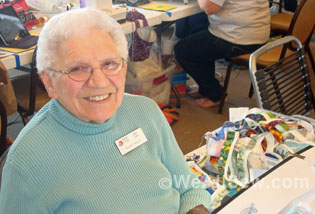Handmade Karma is not running the tutorials for The Farmer's Wife Quilt block tutorials in consecutive order. They seem to be mixing the blocks more according to techniques? Hence, you won't be seeing Blocks 3 and 4 this week, but instead blocks 34-Flock and 59-Night & Day. They put together a schedule so that we can finish the sampler quilt in a reasonable amount of time (1 year vs. 2-3 years.)
I will say that working on a sampler quilt with a different block each time keeps me on my toes. Your brain has to keep working ... What colors to use, in what parts of the block? What technique to attain the best results (paper piecing, templates ...) How big do I have to cut the pieces to make sure they cover the intended space? Plus extra room for seam allowances? You never get into a production mode making multiple copies of the same block, or technique as you do in other quilts. In some respects, practice makes perfect, but in a sampler quilt, each block is the first one. You never get to auto-pilot with a sampler quilt. Ha! What a way to give my brain a workout!
Farmer's Wife Block 34 - Flock
I am using the same beautiful blue Stonehenge. That may be the unifying color / fabric that ties the whole thing together. And some of that curly willow green. I used the sew 2 oversize squares on either side of the diagonal, then cut between the stitching lines. That seemed to work out well. Again, I miscalculated, and wound up with twice as many half square triangles as I needed. That's ok. I'm sure they'll be utilized in some other blocks later in the project. [Despite the wonky photo, the block is square.]
Farmer's Wife Block 59 - Night & Day
That Stonehenge Blue for the night sky, and Sky Blue Fossil Fern for day. With white and a pale green for the star stripes. This block used the paper piecing method again. You build the wedges with 3 pieces of fabric, then trim it down, and sew them together. There's a great confluence of seams on the back side. Paper piecing is still not my favorite technique. Even with practice, I seem to have to rip out stitches because when I miscalculate how the fabric will flip -- and then find out it doesn't cover the patch it was intended to cover. I finally got it in the end ... and the points are pretty darn good on this block.
The name of this block makes me think of Fred Astaire and Ginger Rogers dancing ....
Or the movie Ladyhawke when the curse is broken during an eclipse when they have a day without a night and a night without a day ... Ha! With those two movie references, try to guess my age!






























